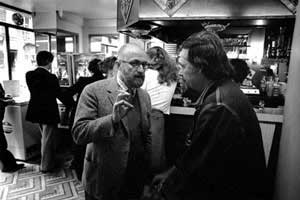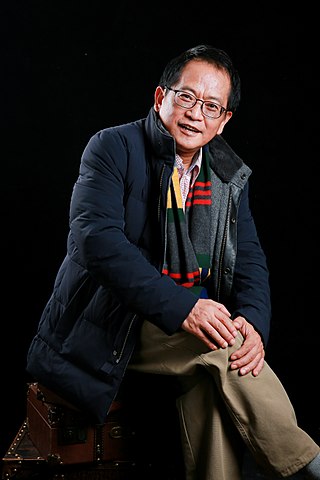Notes
- ↑ Levenson Book Prize Winners Association for Asian Studies (accessed March 15, 2015)
Lothar Ledderose (born 12 July 1942 in Munich) is a German professor of the History of Art of Eastern Asia at the University of Heidelberg. A renowned authority in his field, he received the prestigious Balzan Prize in 2005.
After graduating from the Apostelgymnasium of Cologne he studied East-Asian as well as European History of Art, Sinology and Japanology at the universities of Cologne, Bonn, Paris, Taipei and Heidelberg.
He did postgraduate research at Princeton University and Harvard University (1969–1971) and worked as a translator at Taipei's National Palace Museum (1971–1972). He then became a researcher at Tokio University's Oriental Cultural Institute (1973–1975) and at the Museum of East Asian Art in Berlin. (1975–1976). He successfully submitted his habilitationsschrift at the University of Cologne in 1976.
He is, as of 1984, a corresponding member of the Deutschen Archäologischen Institut (German Archeological Institute) and the British Academy (as of 1996) as well as, since 1986, a full member of the Heidelberger Akademie der Wissenschaften. He has been a board member of the Deutschen Morgenländischen Gesellschaft (German Oriental Society) and, in 1986, president of the ICANAS (International Congress of Asian and North-African Studies) in Hamburg
He was fellow and visiting professor at a great number of academic institutions, among which should be mentioned: Fellow of the Wissenschaftskolleg in Berlin (1983–1984), Senior Mellon Fellow at the Center for Advanced Study in the Visual Arts in Washington (1990–1991), Slade Professor at the University of Cambridge (1992), Murphy Lecturer at the University of Kansas (1994), visiting professor at the Universities of Chicago (1996), Taiwan (1997) and Kyoto (1997), as well as Mellon Lecturer at the National Gallery of Art in Washington (1998) and Scholar at the Getty Research Institute in Los Angeles (2000–2001).
Professor Ledderose is editor of various academic journals, including "Arts Asiatiques" in Paris, "Meishushi yanjiu jikan" in Taipei, "Bulletin of the Museum of Far Eastern Antiquities" in Stockholm and "Scuola di Studi sull'Asia Orientale" in Kyoto
On the occasion of Ledderose's retirement in 2010, an international conference was held from 10 to 12 July at the Cluster of Excellence "Asia and Europe in a Global Context" at Heidelberg University. Under the title "Living Legacies: The History of East Asian Art Reconsidered", experts from Harvard, Princeton, Cambridge, Oxford and other renowned Universities discuss about theoretical and methodological developments in the History of East Asian Art.
His Ten Thousand Things: Module and Mass Production in Chinese Art (2000), which the Association for Asian Studies awarded the Joseph Levenson Book Prize for 2002), argues that modular or standardized production systems were the basis for a wide range of Chinese art, including bronzes, terra-cotta figurines, lacquer, porcelain, architecture, printing, and painting. The Levenson committee commented that "in bridging the divides between 'high art' and 'craft,' connoisseurship and social production, as well as philology and political history, this book is a milestone in the study of art history and material cultures in China. In arguing that Chinese art and culture are just as dynamic as those in Europe, albeit with very different concepts of 'art' and 'creativity,' Professor Ledderose has opened doors for new comparative studies that do justice to both global frameworks and cultural specificities." [1]
An author of more than 170 books and articles, among Ledderose's most notable works are:
His most important scholarly articles are:

Pierre Alechinsky is a Belgian artist. He has lived and worked in France since 1951. His work is related to tachisme, abstract expressionism, and lyrical abstraction.

Karl August Wittfogel was a German-American playwright, historian, and sinologist. He was originally a Marxist and an active member of the Communist Party of Germany, but after the Second World War, he was an equally fierce anticommunist.
Hans Georg Conon von der Gabelentz was a German general linguist and sinologist. His Chinesische Grammatik (1881), according to a critic, "remains until today recognized as probably the finest overall grammatical survey of the Classical Chinese language to date."

Luo Jialun, was the former Chinese Minister of Education, historian, diplomat and political activist. A noted scholar, he was one of the leaders of the May Fourth Movement in 1919. Subsequently, being distinguished as President of various prestigious Chinese universities in the interwar period. In the fall of 1946 he was appointed by the Nationalist Government as China's first Ambassador to India, a full year before India gained sovereignty from the United Kingdom/British Empire. His tenure as Ambassador saw the escalation of the Chinese Civil War and subsequent retreat to Taiwan, of the Nationalist Forces under Chiang Kai-Shek, from whom the Indian Government withdrew diplomatic recognition, according it instead to the victorious Communists under Mao Zedong. Luo remained in India till 1952 when he rejoined his family on Taiwan, where they had retreated with the Nationalists. He continued to live there in his retirement.
Ernest Julius Walter Simon, was a German sinologist and librarian.

Wolfgang Kubin is a German poet, essayist, sinologist and translator of literary works. He is the former director of the Institute for Oriental and Asian Studies at the University of Bonn, Germany. Kubin has frequently been a guest professor at universities in China, for instance at Beijing Foreign Studies University, but also in Madison, Wisconsin, and in Jerusalem. Since 1989, Kubin has been the editor of the journals ORIENTIERUNGEN: Zeitschrift zur Kultur Asiens and Minima sinica: Zeitschrift zum chinesischen Geist.

Wolfram Eberhard was a professor of Sociology at the University of California, Berkeley focused on Western, Central and Eastern Asian societies.
Hellmut Wilhelm was a German Sinologist known for his studies of both Chinese literature and Chinese history. Wilhelm was an expert on the ancient Chinese divination text I Ching , which he believed to represent the essence of Chinese thought. He also produced one of the most widely used German-Chinese dictionaries of the 20th century. He held teaching positions at Peking University and the University of Washington.

Puru, also known as Pu Xinyu 溥心畬, Xinyu being his courtesy name, and Xishan Yishi 西山逸士, which is his sobriquet, was a traditional Chinese painter, calligrapher and nobleman. A member of the Manchu Aisin Gioro clan, the ruling house of the Qing dynasty, he was a cousin to Puyi, the last Emperor of China. It was speculated that Puru would have succeeded to the Chinese throne if Puyi and the Qing government were not overthrown after the 1911 Xinhai Revolution.

Wilhelm Grube was a German sinologist and ethnographer. He is particularly known for his work on Tungusic languages and the Jurchen language.
Qiu Shihua is a Chinese landscape painter. He lives and works in Beijing and Shenzhen.
Vincenz Maria Hermann Hundhausen was a German who was a German-language professor at Peking University and a translator of Chinese works into German. He used the Chinese name Hong Taosheng.

Kang-i Sun Chang, is a Chinese-American sinologist. She is a scholar of classical Chinese literature. She is the inaugural Malcolm G. Chace Professor, and former chair of the Department of East Asian Languages and Literatures at Yale University.

Marguerite Müller-Yao (Chinese: 姚慧; pinyin: Yao Hui; was a Chinese-German painter and art historian. The aim and main subject of her artistic and scientific works were the cultural relations and influences between China and the West.
TaoWang is a Chinese–British archaeologist and art historian specialising in early Chinese art. He is also known for his work on early inscriptions on oracle bones and ritual bronzes. He is married to numismatist and translator Helen Wang.
Wen C. Fong was a Chinese-American historian of East Asian art. He was the Edwards S. Sanford Professor of Art History at Princeton University, where he taught Chinese art history for 45 years. In 1959 he co-founded the first doctoral program in Chinese art and archaeology in the United States, which was later expanded to include Japan. He served as chairman of Princeton's Department of Art and Archaeology, and as consultative chairman for Asian art at the Metropolitan Museum of Art in New York City.

Sheng-Ching Chang is a Taiwanese art historian. She serves as the director of the Graduate Institute of Museum Studies at Fu Jen Catholic University and the professor at the Department of History of Fu Jen Catholic University in Taipei.

Fang Weigui is a Chinese comparative literature scholar, sinologist, and literary translator.

Otto Kümmel was a German art historian, academic teacher, founder and director of the Museum of Asian Art in Berlin and general director of the Berlin State Museums.
Jeong-hee Lee-Kalisch is a South Korean art historian specialising in Chinese painting and archaeology, Korean art, Buddhist art and East Asian ceramics. From 2003 to 2021 she was the Professor of East Asian Art History in the Art History Institute at the Free University Berlin.